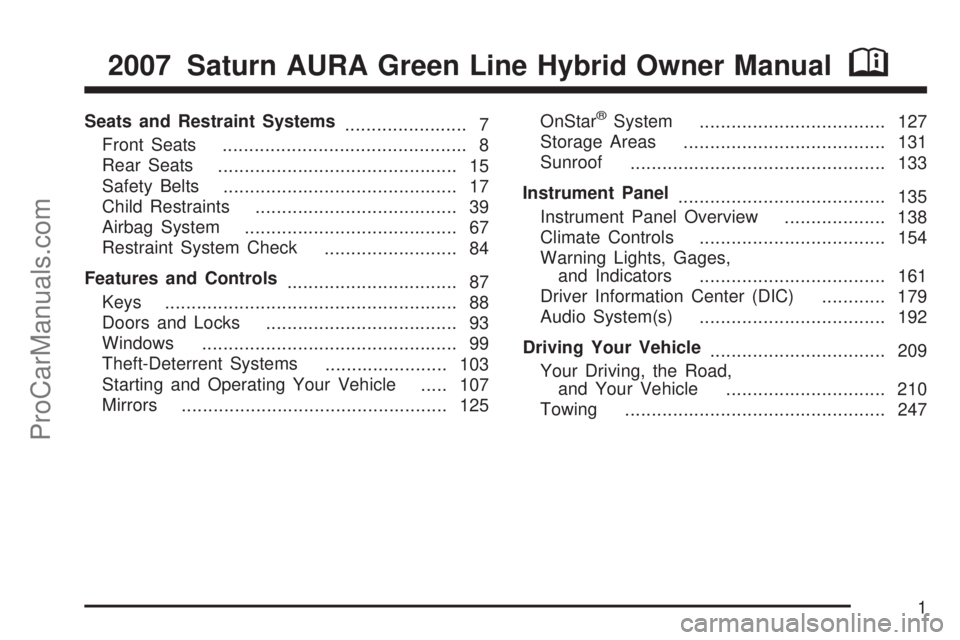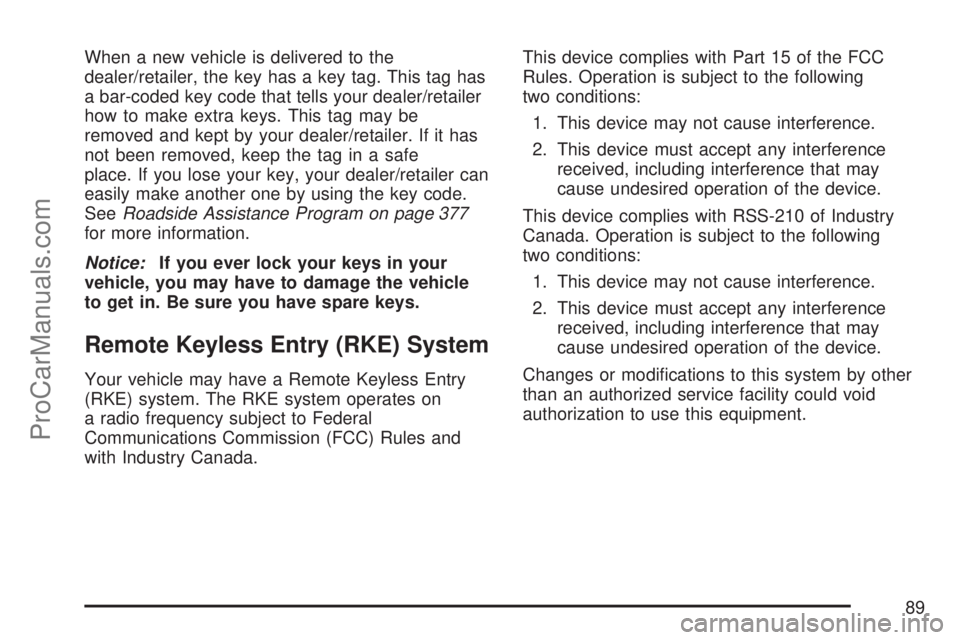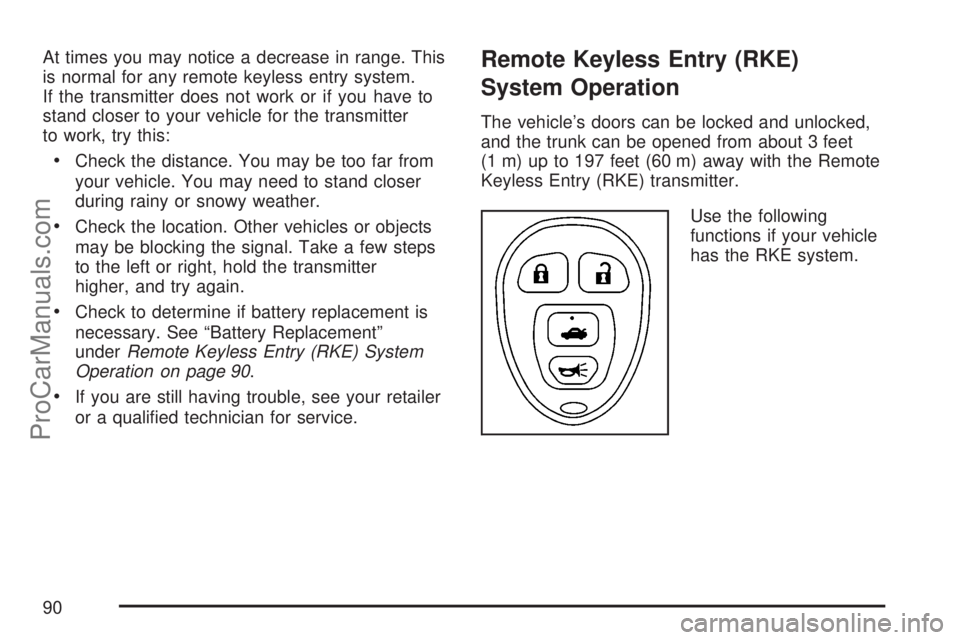key SATURN AURA 2007 Owners Manual
[x] Cancel search | Manufacturer: SATURN, Model Year: 2007, Model line: AURA, Model: SATURN AURA 2007Pages: 406, PDF Size: 6.49 MB
Page 1 of 406

Seats and Restraint Systems
....................... 7
Front Seats
.............................................. 8
Rear Seats
............................................. 15
Safety Belts
............................................ 17
Child Restraints
...................................... 39
Airbag System
........................................ 67
Restraint System Check
......................... 84
Features and Controls
................................ 87
Keys
....................................................... 88
Doors and Locks
.................................... 93
Windows
................................................ 99
Theft-Deterrent Systems
....................... 103
Starting and Operating Your Vehicle
..... 107
Mirrors
.................................................. 125OnStar®System
................................... 127
Storage Areas
...................................... 131
Sunroof
................................................ 133
Instrument Panel
....................................... 135
Instrument Panel Overview
................... 138
Climate Controls
................................... 154
Warning Lights, Gages,
and Indicators
................................... 161
Driver Information Center (DIC)
............ 179
Audio System(s)
................................... 192
Driving Your Vehicle
................................. 209
Your Driving, the Road,
and Your Vehicle
.............................. 210
Towing
................................................. 247
2007 Saturn AURA Green Line Hybrid Owner ManualM
1
ProCarManuals.com
Page 31 of 406

Safety Belt Use During Pregnancy
Safety belts work for everyone, including pregnant
women. Like all occupants, they are more likely
to be seriously injured if they do not wear
safety belts.
A pregnant woman should wear a lap-shoulder
belt, and the lap portion should be worn as low as
possible, below the rounding, throughout the
pregnancy.The best way to protect the fetus is to protect the
mother. When a safety belt is worn properly, it
is more likely that the fetus will not be hurt
in a crash. For pregnant women, as for anyone,
the key to making safety belts effective is wearing
them properly.
Right Front Passenger Position
To learn how to wear the right front passenger’s
safety belt properly, seeDriver Position on
page 22.
The right front passenger’s safety belt works the
same way as the driver’s safety belt — except
for the following.
If you ever pull the shoulder portion of the belt out
all the way, you will engage the child restraint
locking feature. If this happens, just let the belt go
back all the way and start again.
When the safety belt is not in use, slide the latch
plate up the safety belt webbing. The latch
plate should rest on the stitching on the safety
belt, near the guide loop.
31
ProCarManuals.com
Page 87 of 406

Keys.............................................................. 88
Remote Keyless Entry (RKE) System.......... 89
Remote Keyless Entry (RKE) System
Operation................................................. 90
Doors and Locks.......................................... 93
Door Locks................................................. 93
Power Door Locks....................................... 94
Door Ajar Reminder.................................... 94
Delayed Locking.......................................... 94
Programmable Automatic Door Locks.......... 95
Rear Door Security Locks........................... 96
Lockout Protection....................................... 97
Trunk.......................................................... 97
Windows....................................................... 99
Power Windows........................................ 100
Sun Visors................................................ 102
Theft-Deterrent Systems............................. 103
Content Theft-Deterrent............................. 103
PASS-Key
®III+......................................... 105
PASS-Key®III+ Operation......................... 105
Starting and Operating Your Vehicle......... 107
New Vehicle Break-In................................ 107
Ignition Positions....................................... 108Retained Accessory Power (RAP)............. 109
Starting the Engine
(Automatic Engine Start/Stop)................. 110
Engine Coolant Heater.............................. 114
Automatic Transaxle Operation.................. 116
Parking Brake........................................... 119
Regenerative Braking................................ 119
Shifting Into PARK (P).............................. 120
Shifting Out of PARK (P)........................... 122
Parking Over Things That Burn................. 122
Engine Exhaust......................................... 123
Running the Engine While Parked............. 124
Mirrors......................................................... 125
Manual Rearview Mirror............................. 125
Manual Rearview Mirror with OnStar
®....... 125
Outside Power Mirrors............................... 126
OnStar
®System.......................................... 127
Storage Areas............................................. 131
Glove Box................................................. 131
Cupholder(s).............................................. 131
Center Console Storage Area.................... 132
Convenience Net....................................... 132
Sunroof....................................................... 133
Section 2 Features and Controls
87
ProCarManuals.com
Page 88 of 406

Keys
{CAUTION:
Leaving children in a vehicle with the
ignition key is dangerous for many
reasons, children or others could be badly
injured or even killed. They could operate
the power windows or other controls or
even make the vehicle move. The
windows will function with the keys in the
ignition and they could be seriously
injured or killed if caught in the path of a
closing window. Do not leave the keys in
a vehicle with children.One key is used for the ignition and all locks.
88
ProCarManuals.com
Page 89 of 406

When a new vehicle is delivered to the
dealer/retailer, the key has a key tag. This tag has
a bar-coded key code that tells your dealer/retailer
how to make extra keys. This tag may be
removed and kept by your dealer/retailer. If it has
not been removed, keep the tag in a safe
place. If you lose your key, your dealer/retailer can
easily make another one by using the key code.
SeeRoadside Assistance Program on page 377
for more information.
Notice:If you ever lock your keys in your
vehicle, you may have to damage the vehicle
to get in. Be sure you have spare keys.
Remote Keyless Entry (RKE) System
Your vehicle may have a Remote Keyless Entry
(RKE) system. The RKE system operates on
a radio frequency subject to Federal
Communications Commission (FCC) Rules and
with Industry Canada.This device complies with Part 15 of the FCC
Rules. Operation is subject to the following
two conditions:
1. This device may not cause interference.
2. This device must accept any interference
received, including interference that may
cause undesired operation of the device.
This device complies with RSS-210 of Industry
Canada. Operation is subject to the following
two conditions:
1. This device may not cause interference.
2. This device must accept any interference
received, including interference that may
cause undesired operation of the device.
Changes or modi�cations to this system by other
than an authorized service facility could void
authorization to use this equipment.
89
ProCarManuals.com
Page 90 of 406

At times you may notice a decrease in range. This
is normal for any remote keyless entry system.
If the transmitter does not work or if you have to
stand closer to your vehicle for the transmitter
to work, try this:
Check the distance. You may be too far from
your vehicle. You may need to stand closer
during rainy or snowy weather.
Check the location. Other vehicles or objects
may be blocking the signal. Take a few steps
to the left or right, hold the transmitter
higher, and try again.
Check to determine if battery replacement is
necessary. See “Battery Replacement”
underRemote Keyless Entry (RKE) System
Operation on page 90.
If you are still having trouble, see your retailer
or a quali�ed technician for service.
Remote Keyless Entry (RKE)
System Operation
The vehicle’s doors can be locked and unlocked,
and the trunk can be opened from about 3 feet
(1 m) up to 197 feet (60 m) away with the Remote
Keyless Entry (RKE) transmitter.
Use the following
functions if your vehicle
has the RKE system.
90
ProCarManuals.com
Page 92 of 406

Matching Transmitter(s) to Your
Vehicle
Each RKE transmitter is coded to prevent another
transmitter from unlocking your vehicle. If a
transmitter is lost or stolen, a replacement can be
purchased through your retailer. Remember to
bring any remaining transmitters with you
when you go to your retailer. Each vehicle can
have a maximum of four transmitters matched to it.
Battery Replacement
Under normal use, the battery in your RKE
transmitter should last about four years.
The battery is weak if the transmitter does not work
at the normal range in any location. If you have to
get close to your vehicle before the transmitter
works, it is probably time to change the battery.
If the battery is low, a KEY FOB BATT (Battery)
LOW message will display in the vehicle’s DIC.
Notice:When replacing the battery, use
care not to touch any of the circuitry. Static
from your body transferred to these surfaces
may damage the transmitter.To replace the battery in the RKE transmitter do
the following:
1. Insert a �at object, with a thin edge, into the
notch located below the vehicle locator/panic
alarm button, and separate the bottom
half from the top half of the transmitter.
2. Remove the battery and replace it with the
new one. Make sure the positive (+) side of
the battery faces up. Use one three-volt,
CR2032, or equivalent, type battery.
92
ProCarManuals.com
Page 93 of 406

3. Put the two halves back together. Make sure
the cover is on tight, so water will not get
inside the transmitter.
4. Test the operation of the transmitter with the
vehicle.
Doors and Locks
Door Locks
{CAUTION:
Unlocked doors can be dangerous.
Passengers, especially children, can
easily open the doors and fall out of a
moving vehicle. When a door is
locked, the handle will not open it.
You increase the chance of being
thrown out of the vehicle in a crash if
the doors are not locked. So, wear
safety belts properly and lock the
doors whenever you drive.
CAUTION: (Continued)
CAUTION: (Continued)
Young children who get into unlocked
vehicles may be unable to get out. A
child can be overcome by extreme
heat and can suffer permanent injuries
or even death from heat stroke.
Always lock your vehicle whenever
you leave it.
Outsiders can easily enter through an
unlocked door when you slow down
or stop your vehicle. Locking your
doors can help prevent this from
happening.
There are several ways to lock and unlock your
vehicle.
From the outside, use your key or Remote
Keyless Entry (RKE) transmitter, if the vehicle has
one. Turn the key counterclockwise to unlock
the door.
From the inside, lock and unlock the door by
moving the manual lock knob down and up, or by
using the power door lock switches.
93
ProCarManuals.com
Page 94 of 406

Power Door Locks
The power door lock switches are located on the
driver’s and front passenger’s door.
Press the outboard side of the switch to unlock all
doors. Press the inboard side of the switch to
lock all doors.
The rear doors do not have power door lock
switches. Rear seat passengers must use
the manual lock knob on their doors.
Door Ajar Reminder
If one of the doors is not fully closed while the
ignition is on and the shift lever is moved out of
PARK (P) or NEUTRAL (N) the following will occur:
A chime will sound.
The DOOR AJAR message will display
through the Driver Information Center (DIC)
until the door is closed. SeeDIC Warnings and
Messages on page 182.
Delayed Locking
This feature allows the driver to delay the locking
of the vehicle. It will not operate with the key
in the ignition. SeeLockout Protection on page 97.
Press the driver’s power door lock switch or the
Remote Keyless Entry (RKE) transmitter lock
button once. With the key removed from the
ignition and the driver’s door open, the following
occurs:
Three chimes sound to signal the delay.
All doors will lock and the turn signals �ash
once �ve seconds after the last door has
been closed.
The horn chirps if the horn chirp feature is
enabled. SeeDIC Vehicle Personalization
on page 187.
If a door is opened before the �ve seconds has
elapsed, the doors do not lock until �ve seconds
after all doors are closed.
If the power door lock switch or the transmitter
lock button is pressed twice when leaving
the vehicle, the doors lock immediately.
94
ProCarManuals.com
Page 96 of 406

Rear Door Security Locks
Your vehicle has rear door security locks. These
prevent passengers from opening the rear
doors from the inside.
The rear door security
locks are located on the
inside edge of each
rear door.
The rear doors must be open to access them. The
label showing lock and unlock positions is
located near the lock.To set the locks, do the following:
1. Insert the key into the security lock slot and
turn it so the slot is in the horizontal position.
2. Close the door.
When you want to open a rear door when the
security lock is on, do the following:
1. Unlock the door by lifting the rear door
manual lock, using the power door lock switch,
or the Remote Keyless Entry (RKE)
transmitter, if the vehicle has one.
2. Open the door from the outside.
To cancel the rear door security lock, do the
following:
1. Unlock the door and open it from the outside.
2. Insert the key into the security lock slot
and turn it so the slot is in the vertical position.
Security Lock Label
shown
96
ProCarManuals.com